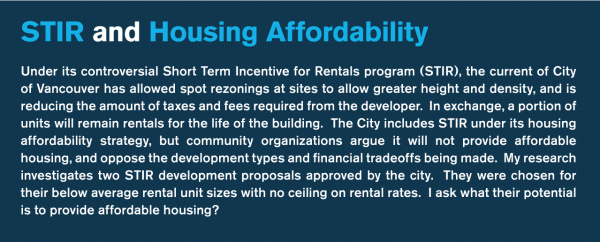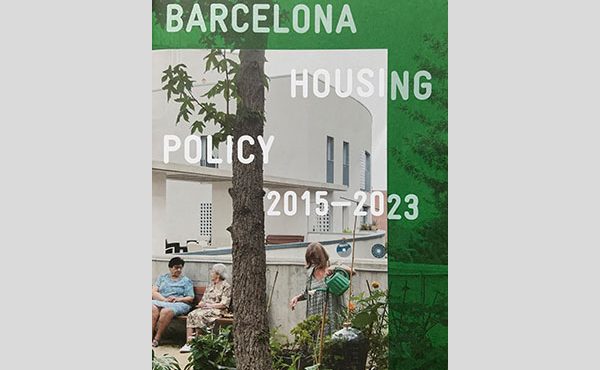
With the Vancouver Mayoral Election heating up, one of the city’s major campaign issues has become affordable housing. Vision Vancouver is indeed declaring it this election’s central issue. With Vancouver having the nation’s highest real estate prices housing affordability has taken centre stage. “Affordable housing” is a phrase we will hear uttered regularly for what remains of the election, and I recommend asking your political party how they define it, and therefore a measure of success in achieving it. Specifically interesting is Vision Vancouver’s inclusion of market rental housing under its umbrella of ‘affordable housing’. With no form of rent control in place, landlords are free to charge a price as high as renters will pay. With no limits I set out to answer what is the potential for affordability?
The spot rezonings under STIR in some cases have allowed significant increases in height and density. At 1215 Bidwell an extra fifteen storeys is allowed above the existing limit of six storeys, making a total of twenty-one storeys. Fees developers pay such as Development Cost Levies and Community Amenity Contributions are waived on rental units (DCL’s and CAC’s). From the city’s perspective rental stock is declining in our city, and developers need incentives to make it financially viable to build rental units. From the perspective of concerned residents, STIR is circumventing existing zoning, relaxing taxes and fees the developer contributes to the community, as well as raising suspicion and accusations surrounding the relationship between developers, politicians, and campaign contributions.
With this in mind, my research investigates two STIR developments approved by the city: 1215 Bidwell at the corner of Davie and Bidwell, and 1142 Granville Street downtown. Both have been approved under STIR, but are also noteworthy for their exceptionally small rental units. Using these developments as a case study, I investigate whether the financial compromises made are likely to provide affordable housing.
Affordability is a complex issue that depends on demographics such as income levels, unit size, household type and rental rates. These influence and lead me to ask: who can afford and choose to live there? Ultimately, affordability is only one aspect of a diverse and livable city; development types and sizes influence who chooses or is able to live in a neighbourhood and consequently the fabric of a community. But how is affordable housing defined?
The most common definitions of affordable housing are based on a percentage of household income spent on shelter. In Canada and BC it is commonly agreed as 30% of household income. The Canadian Mortgage and Housing Commission’s definition of affordability states:
“The cost of adequate shelter should not exceed 30% of household income. Housing which costs less than this is considered affordable. However, consumers, housing providers and advocacy organizations tend to use a broader definition of affordability.”
I chose this definition as a baseline to investigate the developments for their affordability. First, here’s a general overview of the two developments:
1215 Bidwell is a controversial STIR project in the West End. Composed of a mixture of 49 market rental units and 98 market condos, the city approved the rezoning for a twenty-one storey tower over the previous limit of only six storeys. Many residents are concerned about the rezoning, but are also upset about the demolition of Maxine’s (a heritage building), although the development preserves a façade on one side. The average rental unit size is stated as 425 square feet, however the majority of rentals are 390 square feet. No expectations for price were included in the council report, but rents under STIR were assumed between $2-2.50 per square foot.
1142 Granville Street has received less attention probably owing to its location in the entertainment district. Of special interest is the exceedingly small size of the units. The proposal is a 10 storey rental only building with all 106 units at 320 square feet. The developer estimates the rents at $3 per square foot.
Measuring Affordability
As a measure of affordability I use the CMHC’s 30% definition, and also provided the example of a full-time minimum wage after-tax salary. Based on 30% I also calculated the salary needed to make the rent affordable over a plausible range in the rental price. For estimation purposes, I have chosen a range from $2 to $3 per square foot. While rents can be found slightly less than $2 a square foot downtown (mostly in the West End), in new buildings this range is plausible and reflect the developer’s own estimates at 1142 Granville:
“The developer estimates that the units will rent on average for $960 per month. Given the finishing, unit size and design features in this location, staff find the rent levels proposed for this project to be consistent with the STIR program and the City Manager has determined that there is a measure of affordability for this housing.”
Infographic
Please click this link or the thumbnail below for an infographic with a complete visual analysis.
Analysis
When examining affordability one must atleast consider demographic factors such as salaries and rental costs. In this case nobody on low income or unemployed can afford these units at $2-3 per square foot. In addition it is plausible that the size of the units will discourage more than one person from living there; these units do not provide affordability for couples and families. The 320 square foot Granville units would cost $640 per month at $2 per square foot. Not only are they extremely small, they still do not meet the range of affordability (based on CMHC definition) for someone working a fulltime job on minimum wage. Here is the data I used for both developments at the high and low end of the $2-3 per square foot price range (Click image below to see larger text).
Conclusions
While the smallest and least expensive units at 1142 Granville may provide some level of affordability, it does so at the expense of living space. The units at this location are so small that an exception had to be made in the development bylaw for minimum floorspace required (398 square feet). If the estimated rent is closer to developer expectations at $960 per month ($3 per square foot), the units are not affordable (let alone desirable?). Someone would need to make 45K per year to meet 30% level of affordability.
Additionally, the size of the units at both locations means they will largely accomodate only single people. This directly affects to a degree the fabric and makeup of a community. Even for single people the units are poorly adapted to life changes: a relationship, marriage, or starting a family likely necessitates a move to a larger dwelling.
Will a neighbourhood made up of many small units experience higher transience?
I suggest bigger units would suit families or multiple people sharing the rent, and be more adaptable for our communities. I’m curious if the decision toward tiny units is influenced partially by a numerical political bias. Political platforms are partial to boasting their numbers, and units of “affordable rental housing” are immediately halved the moment you double their size to a reasonable living space. I suggest that quantity of housing should be countered with quality of life in discussions up to the election.
And what about STIR? While readers can come to their own conclusions, the numbers and lack of rent control provide no guarantees of housing affordability. The city’s argument of rental affordability seems to lie on the classic economic model of supply and demand when it comes to building rental housing; however, Vancouver’s irrational and speculator driven real estate market makes this suspect or atleast unreliable. Most concerning is that “the City Manager has determined that there is a measure of affordability…” at $960 / mo. for a 320 square foot apartment.
***
Jason Pfeifer is an interdisciplinary designer and photographer with a background in architectural and communication design. He is specifically interested in design decisions that are made (or aren’t made) and the profound effect they can have on outcomes in communities. He is a founding member of Design &, and prior to this operated his independent communication and design firm Juicebox Communications. He’s a graduate of UBC’s Environmental Design program in the school of Architecture and Landscape Architecture, and holds a diploma in Digital and Interactive Media Design.









5 comments
To ask if STIR contributes to affordable housing is like asking if bike lanes contribute to reduced highway congestion. They may be tangentially linked, but the question misses the purpose of the program.
According to the City, STIR “responds to the market rental shortage by providing incentives to encourage the development of new MARKET RENTAL housing. The STIR program is an opportunity to increase rental housing supply during the current economic downturn, while supporting the development industry to maintain jobs and invest in the City’s economy. There is no direct mention of building affordable units. Indeed, the FAQs specifically states that is not the program’s purpose. Moreover, any mention of affordability on the city’s website is in the context of increasing overall rental stock.
While lack of affordable housing is a big issue in Vancouver, so is a lack of market rate rentals. There is a growing percentage of middle income earners who do not aspire to own, but can afford to pay market rental rates and would prefer living in dedicated apartments as opposed to leased condos. This is the market that STIR would seem to address.
Thus the question that should be asked to evaluate STIRs success is not if the program has created affordable units (which it was never meant to do), bur rather if it has increased the number of rental units, both overall and as a percentage of new construction, and/or how many construction jobs were created and maintained.
I have no problems with people criticizing the market-rate orientation of STIR to begin with; but it is misguided to evaluate a program on something that it was never meant to achieve.
Hey Yuri,
Thanks I appreciate the discussion you’re raising here. I 100% agree that the stated intentions of the STIR program are not necessarily around the issue of affordable housing.
However, STIR is now routinely mentioned under the umbrella of affordable housing. The Vision Vancouver platform http://votevision.ca/issue/affordable-housing-homelessness on Affordable Housing and Homelessness includes having “approved over 400 new units of rental housing – the first in over 3 years – throughout Vancouver through Vision’s short-term incentives for rental program”. If STIR is not about affordable housing then it shouldn’t be part of an Affordable Housing Strategy. Because it is under an Affordable Housing Strategy, I’m analysing the potential of STIR to provide affordability which in my opinion it doesn’t.
There are several other issues communities have taken with STIR that the article does indeed address.
To just tag one more thought to Yuri’s, is there evidence one way or another as to whether new rentals of whatever price point reduce the pressure for renovictions? Much as I’d love to be able to build old buildings, it seems that build-new-and-keep-old is at least better than make-old-look-new.
Hi Brian, I haven’t come across or done any focussed research on a relationship between market rental and renovictions, but suspect it would be tough to pull apart. Definitely agree a combination of creation and preservation of housing stock is needed.
Yuri, I had the time to go back and sift through a few notes, and wanted to give more detail on the origins of a deeper relationship between STIR and affordability.
While not originally about affordability, the City Manager is obliged to deem these units “affordable” in order to qualify the projects for waiver of DCL’s. Otherwise, they cannot be exempt of DCL’s under bylaw.
The following council report addresses it and contains this motion that was carried: “THAT Council instruct staff to seek affordability in projects submitted for STIR incentives through finishing, size, location and other design considerations”
http://vancouver.ca/ctyclerk/cclerk/20090618/documents/penv20090618min.pdf
And under the Vancouver Charter amendments were made to allow the DCL waiver on: “for-profit affordable rental housing”, however no definition of affordability is given.
It was a bit dense to cover the depths of this in the article.